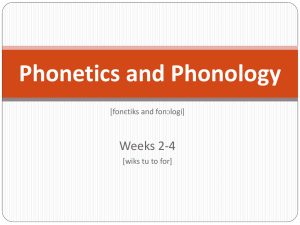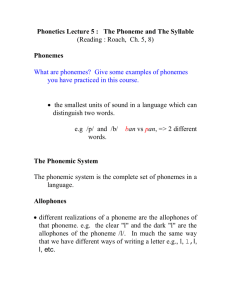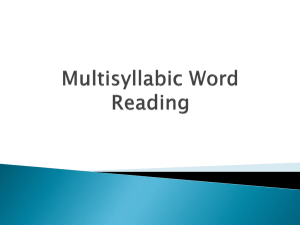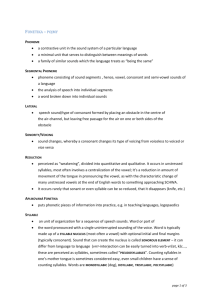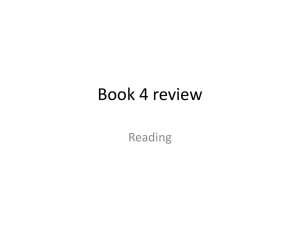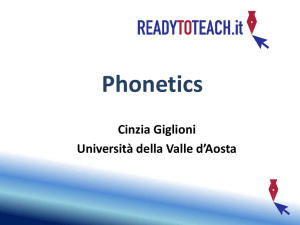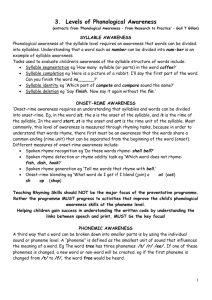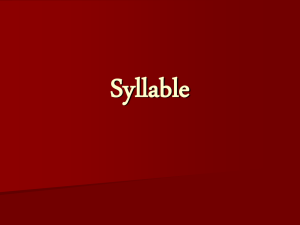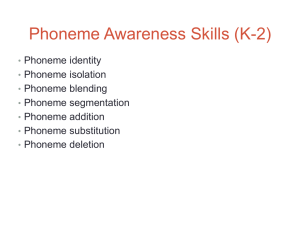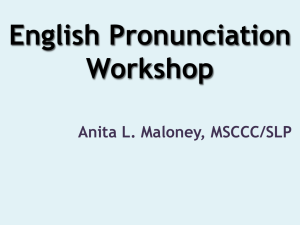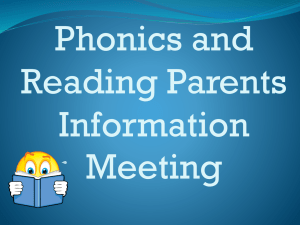LECTURE_6_Phonotactics and syllable
advertisement
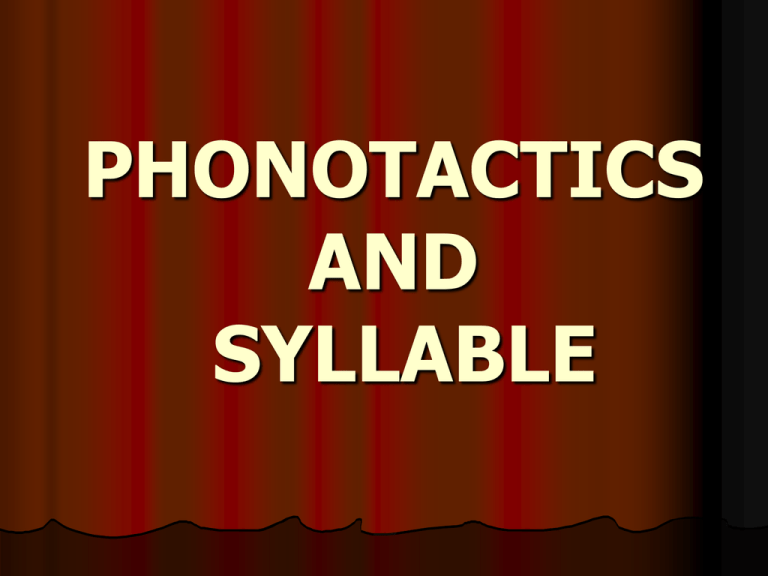
PHONOTACTICS AND SYLLABLE THE PHONEME Speech – continuous stream of sounds Study of speech – dividing the stream into segments The total number of sounds actually produced – infinite; yet, what is important is whether their interchange brings about the change in meaning If yes, the sound is called the phoneme A phoneme - the smallest ‘distinctive sound unit ’ of a language It distinguishes one word from another in a given language. changing a phoneme in a word produces another word, that has a different meaning. In the pair of words (minimal pairs) 'cat' and 'bat', the distinguishing sounds /k/ and /b/ are both phonemes. The phoneme is an abstract term (a speech sound as it exists in the mind of the speaker) and it is specific to a particular language. A phoneme may have several allophones, related sounds that are distinct but do not change the meaning of a word when they are interchanged. The sounds corresponding to the letter ´t´ in the English words 'tea' and 'trip' are not in fact quite the same. The position of the tongue is slightly different, which causes a difference in sound detectable by an instrument such as a speech spectrograph. Thus the [t] in 'tea' and the [t] in 'trip' are allophones of the phoneme /t/. ALLOPHONES If there is a strict separation of places where particular realizations of a phoneme (i.e. allophones of a phoneme) can occur, they are said to be in complementary distribution (e.g. the aspirated and unaspirated realizations of ´t´, like in ´tin´ and ´trip´) SYLLABLE Just like sounds, syllables can be defined both phonetically and phonologically Phonetically: they consist of a centre with minor or no obstruction to the airflow, and the beginning and end with greater obstruction to the airflow Phonologically: vowels and consonants having different distribution SYLLABLE Minimum syllable: a single vowel in isolation: /a:/, /כּ:/, /∫/, /m/ Some syllables have an onset (more than silence before the central vowel): ´bar´ Some syllables have a coda more than silence after the central vowel): ´ease´ Some syllables have onset and coda: ´run´ PHONOTACTICS is the study of the possible phoneme combinations of a language: what can occur at a word beginning or end In English, a word can begin with a vowel, 1, 2, or 3 consonants In English, a word can end in a vowel, 1, 2, 3 or 4 consonants SYLLABLE INITIAL SOUNDS - - Syllable onsets: A vowel (any vowel but /υ/) = zero onset A consonant (any cons. but /ŋ/,/ζ/ is rare) Two or more cons. = consonant cluster pre-initial /s/ + initial /p/,/t/,/k/,/f/,/m/,/n/,/l/,/w/,/r/,/j/ (´sphere´) a set of some 15 cons. as initial + one of cons. /l/,/r/,/w/,/j/ as post-initial (´clear´) Three-cons. initial cluster: pre-initial /s/ + initial /p/,/t/,/k/ + post-initial /l/,/r/,/w/ (´split´) SYLLABLE FINAL SOUNDS - - Zero coda = no final cons. Final cons.=any cons. except /h/,/r/,/w/,/j/ Two-cons. clusters: pre-final /m/n/ŋ/l/s/ + final (´bank´) final + post-final /s/z/t/d/θ/ (may be separate morphemes) (´beds´) Three-cons. clusters: pre-final+final+post-final (twelfth) final+post-final 1 +post-final 2 (fifths) pre-final+final+post-final 1+ post-final 2 (twelfths) final+ post-final 1+post-final 2+ post-final 3 (sixths) BORDER CASES? Syllabic consonants at the centre of the syllable instead of a vowel Q: How many syllables are there in ´students´ /´stju:dnts/? A: One or two!!! RECENT PHONOLOGICAL TIPS Syllable rhyme onset peak (centre/ nucleus) coda SYLLABLE DIVISION Alternative analyses possible in many cases: e.g. ambisyllabic cons. in ´carry´ The ´extra´ case – much discussed The ´standing´ case – much discussed The ´boundary´ case – much discussed No obvious way of deciding whether to follow the phonetic (CVC) or grammatical instinct (base form + extension)

